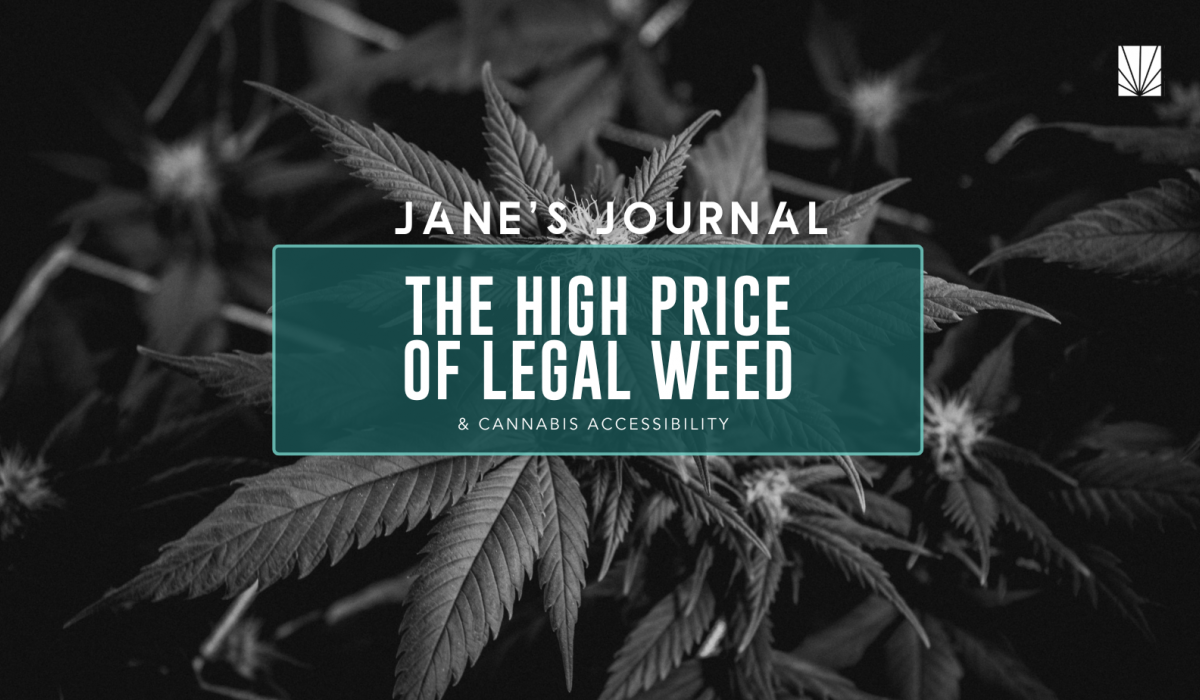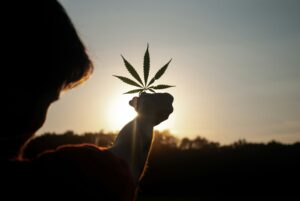
The High Price of Legal Weed & Cannabis Accessibility
Weed is currently more accessible than it has been in generations. Three out of four U.S. states have legalized cannabis for medical or recreational use, or both. In fact, nearly 90% of American adults are in favor of legalization and half of Americans have used cannabis at least once in their lifetimes.
Not only are there more legal dispensaries than ever, prices continue to drop as new markets come online. In 2024, Yahoo reported, “weed has never been so cheap in America. The retail price of a gram of cannabis dropped 13% to $9.43 in Q3 of 2022 from $10.83 in the same period the previous year – the steepest fall ever seen for marijuana in a 1-year period.”

Yet, for many medical cannabis patients and disabled Americans, there are still significant barriers to cannabis accessibility. For instance, the ongoing friction between federal prohibition and state-by-state legalization puts medical cannabis patients between a rock and a hard place when it comes to the Americans with Disabilities Act (ADA) and other federal protections.
Additionally, some legal markets place limits on the kinds of cannabis products medical card holders can purchase. And of course, ableism and cannabis stigma continue to flavor the industry in ways large and small.
So why hasn’t cannabis accessibility increased as weed prices have dropped precipitously in established markets like California and Colorado? Let’s delve into some of the major obstacles for medical cannabis consumers…
Prohibitionist Public Health Recommendations
Every medical and adult-use cannabis market in the country owes its existence to the medical cannabis movement (and also the LGBTQIA+ community). So it’s one of the great ironies of legal cannabis that so many of the regulations which shape medical and adult-use markets are informed by public health recommendations that take their cues not from medical cannabis patients or the disabled community, but anti-drug messaging.
For example, a page on the Illinois Department of Public Health (IDPH) website directly states, “Cannabis is not a harmless drug. Someone who uses cannabis may not do as well in school and may have trouble remembering things. Cannabis use can lead to substance use disorder, often referred to as addiction.” There is no mention on this page of medical cannabis, although Illinois has legalized both medical and recreational cannabis markets.
Another example of this deeply rooted in anti-drug messaging, can be seen in an article from the news desk of Florida Atlantic University regarding a study on how disabled cannabis consumers perceive the risk of partaking. There is no mention in the article of why these “vulnerable populations such as women of childbearing age with disabilities” might turn to cannabis consumption for medical purposes—including the proven efficacy of medical cannabis for gynecological conditions. However, the article does describe reproductive-aged women who use cannabis as “at risk of substance use” and refers to the potential for substance use disorders and addiction.
Also consider potency cap legislation, whose proponents frequently cite concerns about the potential impact of high-potency cannabis on minors who get their hands on products like edibles, concentrates and vape carts. While preventing children and adolescents from inappropriate exposure to cannabis is an important cause, these arguments and proposed solutions rarely acknowledge that medical cannabis patients tend to seek out more potent THC products to help manage conditions like chronic pain without the use of powerful pharmaceuticals like opioids – a class of drugs that, according to the National Center for Drug Abuse Statistics, claims the lives of over 69,000 people per year in the United States alone.
The result of this one-sided paradigm is hard to open packaging that is not only “child-proof” but also often feels “patient-proof” – further reducing accessibility for those who need it most, fueling stigma around consumption and endorsing the lack of public places where people can safely consume medicinal cannabis.
Friction with Federal Prohibition and the ADA
Public health isn’t the only element of the current legal cannabis paradigm that’s been influenced by federal prohibition. Employment and housing protections for medical cannabis patients remain in a legal gray area under the Americans with Disabilities Act and other federal policies.
At a time when 50% of American adults say they struggle to afford health care costs and when it’s increasingly challenging to afford medical insurance without coverage subsidies from full-time employers, people with disabilities face higher rates of unemployment. Adding to that burden, the EEOC has ruled the ADA does not protect medical cannabis consumption, leaving many disabled medical cannabis patients vulnerable to workplace drug testing and adverse action by employers – though now, some states such as California, are taking action to change that.
Similarly, neither the ADA nor the Fair Housing Act (FHA) protects medical cannabis patients from discrimination because, according to a 2011 memo from the US Department of Housing and Urban Development (HUD), “persons who are currently using illegal drugs, including medical marijuana, are categorically disqualified from protection under…disability definition provisions.”
That means even in states with legal medical and adult-use cannabis markets, Public Housing Agencies (PHA) and HUD will not admit anyone who consumes cannabis. This creates an additional barrier to housing access for a population that is already critically underserved and housing insecure. As of 2022, researchers discovered 18 million people with disabilities were eligible for, but had not received, federal housing assistance.
Additionally, most rental properties have anti-smoking clauses in the lease even if they aren’t federally funded and managed public housing. So unless a disabled person lives with a friend or family member who owns their own home or manages to achieve homeownership themselves, options for legal inhalable cannabis consumption are limited.
While homeownership is increasingly out of reach even for able-bodied would-be purchasers, the American dream is even further out of reach for people with disabilities. According to Freddie Mac, 40% of renters with disabilities sometimes couldn’t even afford essential food and housing costs, 47% said their residence was not fully accessible and 51% could not afford a down payment on a home.
As long as current trends in the housing market continue and public consumption spaces and cannabis hospitality venues are held back by current regulations, that means people with disabilities will have reduced access to safe, legal places to consume plant medicine.
Incarcerated people with disabilities also suffer under federal prohibition. As the Prison Policy Initiative has found, 40% of people in state prisons and 29% of people in federal prisons are disabled—but even in states with legal cannabis markets, incarcerated people cannot access medical cannabis or consume it on supervised release.
Ableism Within the Cannabis Industry
Even within the cannabis industry itself, there are accessibility barriers for medical cannabis patients. Cannabis brands’ websites may not be fully accessible, for instance, with web design and UX features that aren’t functional for people with limited vision or color blindness or don’t feature alt text for the blind. Most dispensary staff are not fluent in American Sign Language and do not have an interpreter or captioning available for Deaf and hard-of-hearing customers.

Those disparities aren’t out of step with the degree of accessibility present in other industries. However, they do stand out in a retail sector so intertwined (both historically and in the present moment) with the needs of our disabled and marginalized communities.
Unfortunately many of the accessibility issues within the cannabis industry are, like a majority of the public health regulations around cannabis, the result of developing policy without meaningful and substantial input from those who use medicinal cannabis to manage medical conditions and disabilities.
In Iowa, for example, medical cannabis patients cannot purchase flower—only concentrates, edibles and other extracted cannabis products. Not only does this limit patients in their ability to select the best consumption method for their needs, but it also artificially inflates the cost of cannabis products for medical consumers.
In numerous states, including Minnesota, home grow limits also curtail cannabis accessibility for medical patients, especially those who want to control certain inputs like pesticide and fertilizer use during the cultivation process.
The Accessibility Barriers to Medical Cannabis Programs
And, of course, there’s the way medical cannabis programs themselves are structured. The cost of a medical cannabis card can run into hundreds of dollars and require setting appointments that present additional logistical challenges, particularly for cannabis patients who are on fixed incomes, receive government assistance, or rely on public transportation or transportation assistance from caregivers.
That’s one reason not all people who use cannabis medically bother getting a medical card in states with adult-use markets—the tax relief and increased purchase limits aren’t always worth the trouble of getting medical cannabis patient status established.
Even with differences in purchase limits and pricing for medical cannabis patients and historically low prices, not everyone can afford to shop for cannabis regularly, in the quantities needed, or at all. But laws around donated cannabis product for medical cannabis patients and compassionate care programs like This Is Jane Project can vary widely from state to state.
Why Everyone Should Care About Cannabis Accessibility

Problems with cannabis accessibility may feel like niche issues to many able-bodied Americans. After all—cannabis is more accessible than ever. Prices have never been affordable. Legal risk has never been lower for most American adults. Yet, those advances aren’t felt proportionately by the communities that have been most impacted by cannabis prohibition, including communities of color and the disability community.
Consider this: disability is one of the largest cohorts of marginalized people in the country. It’s also one of the most intersectional and permeable groups. Unlike race or sexual orientation, for example, anyone can become disabled at almost any point in their lifetime.
Disability can and does affect people already living with the impact of racism, gender inequality, homophobia and/or transphobia, and other systemic inequalities. In fact, the impact of prejudice and discrimination can not only coincide with disability but may also cause or contribute to it.
Medical racism or transphobia, for example, can cause conditions to go undiagnosed and untreated, resulting in lasting health consequences including chronic illness, disability or mortality. Financial inequality disproportionately impacts marginalized groups and can also exacerbate disability or serve as an extenuating circumstance, as with food insecurity or a lack of access to health insurance or mental health care.
Not only can disability stem from traumatic events or systems of inequality that contribute to individual and intergenerational trauma, but disability can also be traumatic in and of itself. Disabled people are more likely to be victims of violence, abuse, and stigma—not to mention how a lack of access to care can be traumatic in and of itself.
Shame and stigma around marginalized identities, from misogyny to fatphobia, can limit access to medical care. For people who suffer from medical trauma or distrust of the medical establishment, medical cannabis can be enormously appealing because it can be purchased in a retail environment that isn’t medicalized in the same way as, say, a clinical setting or pharmacy.
It’s true that we will probably see the commercial cost of cannabis continue to decline; but until cannabis regulations fully address the unmet needs and accessibility concerns of medical patients and disabled consumers, the legal cannabis market will continue to have hidden costs for the communities who need it most.
cannabis accessibility, cannabis prohibition, cannabis regulations, legal weed, marginalized groups, medical cannabis, public health, Socioeconomic Disparities
